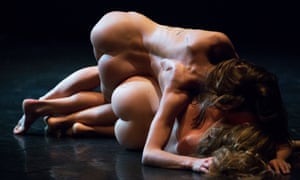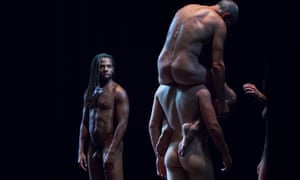
I am still processing (Some)Body when I take my front-row seat at the larger Zoo Southside venue, for Dep, where I am met by six, lit-up nude performers. The audience too, is illuminated. Minutes pass. A field recording of a Vietnamese funeral chant – choreographer Dam Van Huynh did six weeks’ research in the country – breaks the silence.
Van Huynh was born in Vietnam, but left after the war when he was five, and moved to the US. Now based in the UK, he was keen to explore his cultural heritage. One of the ideas that interested him was how, in Vietnamese culture, death is also a form of rebirth. When a person dies, “the family and community enact rituals that will enable the deceased to pass into another realm”.
When people talk about being on the edge of their seat, a penalty kick in a World Cup final comes to mind, or the million-pound quiz question. But throughout Dep, I am on the edge of my seat. Even when the only thing being anticipated is stillness. At other times the dancers run at such speed that they collide, like molecules knocking into each other. They carry each other’s prone bodies; writhe and convulse on the floor, fish drowning on dry land. At one point, two dancers are arranged by the others to rest towards each other in a sort of inverse position to Marina Abramovic and Ulay’s famous Rest Energy piece.
None of the performers has ever danced naked before. “I feel constantly a mixture between strong or vulnerability,” Ieva Navickaite says. Her colleague, Marta Masiero, adds: “Definitely everyone faced some psychological things. We worked towards finding each other and building trust, finding a vocabulary that we could all share.”
The rapport between the dancers is apparent both when they dance and when they chat. It is a multinational group: British (Marley Seville, Paul Davies), Lithuanian (Navickaite), Italian (Masiero, Tommaso Petrolo) and French (Marc Krause). The dancers are representative: white, black, older, younger, differing in body shape. The colour referred to by the word “nude” is almost always salmon-pink, which is obviously not the case. Masiero talks about how the female dancer’s naked body is often androgynous and flat-chested. “For me that was slightly daunting. But [Dep] has helped me accept the way I am and find incredible freedom within my body.” It’s a point all of the dancers agree on.

Repetitive movements are reminiscent of tribal rituals, some primal. While Van Huynh chose the title Dep, which means beautiful in Vietnamese, I ask the dancers if they can describe the work in just one word. Their answers are as follows: “Resilience”, “human”, “an eyeful”, “introspective” and “alive”.
